Elizabeth Stewart's Blog
September 6, 2025
Nomad Tango Presents Malena
Nomad Tango Executive Director Alejandra Folguera joins choreographer and dancer Fernanda Ghi to talk about the production of Malena—the story of a woman’s rebellion and her fight to claim her freedom at the Lobero Theatre on Saturday, September 6.
Watch Video

The post Nomad Tango Presents Malena appeared first on Elizabeth Appraisals.
September 2, 2025
The Seven Gods of Fortune
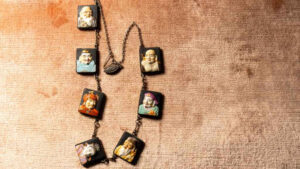 JE owns a wonderful 1900s vintage Japanese necklace composed of faces of benevolent gods. The links are porcelain on sterling.
JE owns a wonderful 1900s vintage Japanese necklace composed of faces of benevolent gods. The links are porcelain on sterling.
The faces, and the gods they belong to, are important to Japanese mythology, the Seven Gods of Fortune. We see them pictured on kimono toggles called netsuke, and in woodcuts since the 1600s. Although this necklace pictures them individually, they’re often grouped together on a ship at sea, a lovely ship of treasures. Tradition calls those treasures: longevity, prosperity, popularity, integrity, dignity, kindness and magnanimity. The gods that personify each virtue bestow these blessings. Although the Seven Lucky Gods are immortal, the Buddhist priest of the powerful Shogun Mikawa “discovered” the gifts they bestow on good people in the 1500s. The Seven Gods, called the ‘Shichifukujin’ have been recognized in art—and it seems, in dreams, for over 500 years. Let’s meet the Gods and what they embody. Then we’ll meet them in dreams.
In order of the necklace, the Seven Gods:Ebisu, a god of Japanese origin, who reigns over fishermen, farmers, and merchants, and stands for integrity. We see Ebisu pictured on Sapporo Beer cans! Ebisu is celebrated at his shrine in Osaka each year in a race in which the fastest runners compete. Those who win are the “lucky men” blessed with a year of good fortune.Daikokuten is the god of wealth, prosperity and agriculture, akin to the Hindu Shiva, who destroys and creates.Benzalten is goddess of kindness, the only female, and rules over wisdom and music.Bishamonten is dignity, a warrior god.Fukurokuju is popularity and good luck for and with children.Jurojin is longevity, pictured with a deer, he cures illnesses.Hotei is magnanimity, and he carries a sack to give to the poor. He grants wishes.The Toshikane Company made this necklace in the first or second quarter of the 20th century in the rich porcelain making area of Arita. Chief designer Minami designed sculptural objects prior to World War II.
After the war, Japanese companies resumed private export trade in 1947. Thus, these necklaces and buttons made with faces of the gods sold as souvenirs through military bases in Japan and Guam to western servicemen. Surprisingly, the Toshikane Company continued to make “Gods of Fortune” buttons, in the style of Japanese Noh Masks, until 1975. The necklace bears a stamp “made in occupied Japan” The Seven Gods necklace is circa 1940s, happy porcelain faces set upon silver, linked with a silver chain.
Prized Jewelry and Lucky DreamsThese masks on jewelry are prized, as the gods are powerful and immortal. People have celebrated them for centuries in Edo (now Tokyo). Pilgrims visit the shrines of each of the lucky gods there in the new year. Wear this necklace to undertake the walking “Yahaka” pilgrimage to each of the seven shrines. If you cannot visit the seven shrines, the traditional practice is to invite these gods into your home. Do this as a custom. Sketch each god in their pleasure ship on paper, and on New Year’s Eve, place that sketch under your pillow. This encourages the lucky “first dream” of the New Year.
The tradition of “hatsuyume” (first dream) indicates the vision you see as you doze at the start of the year will predict the next twelve months. Hatsuyme originated in the 1660s with the first Edo shogun. One of Japan’s most powerful rulers, he lived in the shadow of Mt Fuji, Japan’s tallest mountain, and kept the fastest hawks for his hunt, and the earliest seasonal purple eggplants to eat.
Every New Year, hawkers in the streets sell sketches of the Seven Lucky Gods in their ship. This is because not everyone can draw, and putting such a work of art, called a ‘takarabune’ picture under your pillow increases the chances of a great dream of
Mount FujiHawksEggplantsThe Seven Gods increase the chance you’ll dream of these three, and if you want added protection, ask for a sketch of the Kanji Monster who eats bad dreams.
The value of the lucky gods necklace is $500. But if JE owns a set with hair ornaments and earrings and a bracelet, the value is $1,000.
The post The Seven Gods of Fortune appeared first on Elizabeth Appraisals.
August 31, 2025
Lies at Center Stage Theater
Director R. Michael Gros and playwright Jerry Slaff join founders of DramaDogs A Theater Company, E. Bonnie Lewis and Ken Gilbert, to talk about the West Coast premiere of Lies at Center Stage Theater.
Watch Video

The post Lies at Center Stage Theater appeared first on Elizabeth Appraisals.
August 26, 2025
Atmos Mantle Clock A Go-To Gift
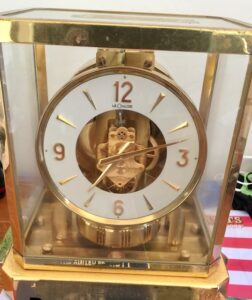 Imagine a clock that winds itself based on changes in atmospheric pressure. This Atmos clock doesn’t need a human. It winds itself with the help of a sealed bellows of ethyl chloride. When the temperature rises, the metal spring condenses. When the temp falls, the metal spring expands, and the mainspring winds. Because the clock is so delicate, a pendulum with practically no friction and hangs off a wire thinner than a human hair. This Atmos clock is the brand of a torsion pendulum clock made by Jaeger-LeCoultre of Switzerland.
Imagine a clock that winds itself based on changes in atmospheric pressure. This Atmos clock doesn’t need a human. It winds itself with the help of a sealed bellows of ethyl chloride. When the temperature rises, the metal spring condenses. When the temp falls, the metal spring expands, and the mainspring winds. Because the clock is so delicate, a pendulum with practically no friction and hangs off a wire thinner than a human hair. This Atmos clock is the brand of a torsion pendulum clock made by Jaeger-LeCoultre of Switzerland.
Clocks that ran on atmospheric pressure were invented in the 17th century and refined throughout the 18th century.
A particularly noteworthy torsion pendulum clock is the Beverly Clock in Dunedin New Zealand. A human hasn’t touched it since 1864. It still tells accurate time.
I love this Gold and Crystal Atmos nine-inch mantel clock with its modern case. HK’s grandfather received it as a gift like many VIPs in the mid-20th century. Many boxed Atmos clocks were presented since the 1940s. Not the least of the ‘givers’ is and was The Atmos Mantle Clock became the go-to gift for the Swiss government to give visiting dignitaries since the 1950s.
The brand is my favorite:The US version is gold-plating over brass with five panel crystal casing. The Swiss made other models for dignitaries from Japan, featuring views of Mt Fuji and a pagoda. The Marina design features motifs of the ocean. The ribbed brass model and a round or square faced model sell at auction under $1,000. Black enamel round-face models go for $1,500. The clock shows different outward casing styles but technically contains the same internal workings since 1946. From retirement to wedding gifts, the Atmos reflected a relationship honored because Atmos reflected reliability, dependability, accuracy, and beauty.
A version of the Atmos mantel clock called the Moonphase retails today, used, for $10,000. It’s the same torsion pendulum Atmos clock set in a case of plated Rose Gold and crystal. The difference is that the Moonphase tells the time, month, and moon phases, and is NOT accurate only once in every 3,821 years.
Swiss engineer Jean-Leon Ruetter invented the Atmos in 1928. It became commercially produced by Jaeger-LeCoultre in 1936. Antoine LeCoultre formed Jaeger-LeCoultre in 1833. They’ve patented thousands of clock movements. For example, the world’s smallest movement, the world’s most complicated movement, and the perpetual movement of the Atmos clock.
Wristwatches Too!My business manager Shawn collects unique wristwatches. He loves the wizardry of the Tourbillion movement Jaeger-LeCoultre Grand Complication. Called the Hybris Mechanica a Grand Sonnerie this wristwatch designed in 2009 will set you back $2.5 Million. For $2.5M you get treats for the ear. Sonnerie means ”chimes,” and yes, the watch contains miniature tiny gongs and hammers that play miniature chimes inside that watch. Because of its 1,300 parts and complex tiny gears, it plays the entire Big Ben Chime Song. It also plays the Westminster Chime Song as well as showing you the time and perpetual calendar for the date, day, month, and leap year. The challenge to the watchmaking industry in the creation of the Grand Complication, is the precise engineering needed to find more complexity in a relatively small wristwatch. To solve the complexity problem in mechanically engineered miniature ways that are NOT digitally based, but mechanical.
If, in 1980, your Casio beeped every hour, this $2.5Million dollar Hybris Mechanica a Grand Sonnerie wristwatch will play amazing tiny chimes. It comes delivered with its own 450 pound safe and two back up watches.
Over the length of its career as THE premier Swiss mantle clock, the Atmos has undergone various models and changes to its horology, but the essential engineering remains the same. However, in the last few years a LeCoultre designer developed the ‘Atmos Mysterieise,’ a most gorgeous torsion pendulum mantel clock set in a case with a base covered in cream colored shagreen (shark’s hide), and mother of pearl, with a Baccarat crystal cloche, which hermetically seals the Atmos horological movement. The case comes accented with 9.35 carats of diamonds and retails for $230,000.
The value of the 1960s era Atmos is $500. HK reports it’s in working order and she wants to sell. Contact me if interested.
The post Atmos Mantle Clock A Go-To Gift appeared first on Elizabeth Appraisals.
August 24, 2025
Chris Bailey and the Lobero Theatre Eagle
Brigette Ginter interviews artisan Chris Bailey about his restoration of the Lobero Theatre Eagle.
Watch Video

The post Chris Bailey and the Lobero Theatre Eagle appeared first on Elizabeth Appraisals.
August 19, 2025
How to Sell a Bapende Mask?
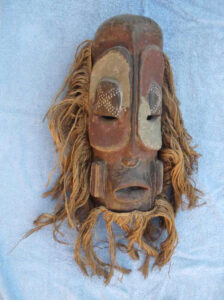 Frightening yet beautiful, this wooden and polychromed (painted with many colors) carved Bapende mask from Zaire belongs to a group collected by a world-famous celebrity. The current owner asked, “Where can I best sell these masks?” Indeed this collection is superb and varied.
Frightening yet beautiful, this wooden and polychromed (painted with many colors) carved Bapende mask from Zaire belongs to a group collected by a world-famous celebrity. The current owner asked, “Where can I best sell these masks?” Indeed this collection is superb and varied.
The late wife of a reader purchased the masks in the early 1980s in Nairobi, Kenya, from the collection of actor William Holden. Holden’s partner, Stefanie Powers, sold the masks to benefit The William Holden Wildlife Foundation, which she created after his death. The foundation still operates as an educational facility in Kenya. The Academy award-winning actor amassed a world class collection of masks, one of which ended up donated to the Palm Springs Art Museum in 1982.
Cultural Sensitivity of African Masks Collected During Colonial EraCapitalistic colonizers, French, English, and Belgian dealers acquired many in the 1920s. They realized the market potential of the taste for the exotic and the growing understanding of the abstract nature of modern art, conceptualized by artists such as Klee and Picasso.
The collection amassed by Holden (1918-1981) was known for its connoisseurship. He co-founded the Mount Kenya Safari Club (1959) and established a game ranch focused on wildlife preservation. As he grew older he became increasingly concerned with various animal species declining in population.
Another mask in the group is a Baule mask from the Ivory Coast. In the 1980s I served in the Peace Corps and took long weekends in the Ivory Coast. The Baule people inhabited the east side of the Ivory Coast, part of the Akan people of West Africa’s Ghana and the Ivory Coast, known for their gold talismans, brass castings, and wooden figural sculptures. Their masks are their foremost art form. I purchased mine in the mid 1980s and it hangs on a white wall in front of my desk.
During the last half of the 19th century to the first quarter of the 20th century, only an important individual from a powerful family owned such a Baule mask. When worn, the soul of the mask is transmuted through the “dancer’s” face. He, dancers were always male, transformed into the representation of the mask. He became a deity, an ancestor, or animal spirit. The mask allowed the spiritual world to interact with the physical world, facilitating communication between ancestors and heirs, humans and deities, humans and animals, low born villagers and high born, men and women, earth and sky.
Two Divine Beings at the Heart of Baile SpiritualityThese are the creator god Nyamien, and Asie, the God of the Earth, lord of humans and animals. The soul is immortal, and therefore beholden to its ancestors.
The mask pictured is a portrait mask and might depict a forebearer of the dancer. This mask shows the physical features of an honorable person: the slit-eyes represent modesty, the open mouth and folds, age, the hair and beard wisdom.
Let’s imagine this mask “danced” in a ceremony in the early 1900s. Before the ceremony this mask may have been kept “sleeping” in a personal shrine until its command performance in a “masquerade.” The masker or dancer wears a fiber costume, and danced to drums, to singing, and spoken words. The mask became the actor in a skit and the actor became the mask.
Here’s the cultural conundrum and why the sale of these masks is a delicate topic. Although this mask is a stunning three-dimensional work of art, the mask wasn’t intended as a wall-hanging. Why? The mask initiated movement. The mask holds the power to act, and to remain static on a wall belies its power. I’m to blame as well. My Baule mask is on my wall as I write this. I “see” form, color, texture, and abstraction of the human face. I KNOW I should feel, as did the Baule masker/dancer in 1900, its power of action and creation.
The static, formal properties of the mask “create” value for it in the European and US marketplace; the mask, if sold at auction, would realize over $2,000. I would suggest Skinner Bonhams auctions for the sale of such a mask.
The post How to Sell a Bapende Mask? appeared first on Elizabeth Appraisals.
August 17, 2025
Art Historian Brigette Ginter
Art Historian Brigette Ginter talks about art appraisal.
Watch Video

The post Art Historian Brigette Ginter appeared first on Elizabeth Appraisals.
August 12, 2025
Maxfield Parrish Prints a Great Addition to Any Wall
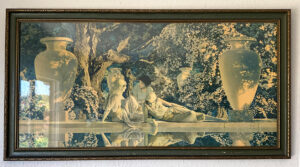 Maxfield Parrish (1870-1966), an American Quaker master of the fantastic, created a commercial style also recognized as fine art. Known as a book and magazine illustrator in great demand, an advertising man, the creator of a color called “Parrish Blue,” and one of the most popular artists of the 20th century. In 1936 Time magazine listed the three most popular artists, as far as fine art reproductions sales went, Cezanne, Van Gogh, and Parrish.
Maxfield Parrish (1870-1966), an American Quaker master of the fantastic, created a commercial style also recognized as fine art. Known as a book and magazine illustrator in great demand, an advertising man, the creator of a color called “Parrish Blue,” and one of the most popular artists of the 20th century. In 1936 Time magazine listed the three most popular artists, as far as fine art reproductions sales went, Cezanne, Van Gogh, and Parrish.
What does fantastic exotic art have to do with DC, who grew up in a Pedregosa Street 1900s home in Santa Barbara? In the early 1970s she and her brother became enchanted by The Lute Players (1924) and The Garden of Allah, prints by Maxfield Parrish. Let me explain the themes, and why in the 1970s DC fell love with works created in the first quarter of the 20th century.
Equally exotic Maxfield Parrish PrintsI’ll analyze a few of these that stem from a treasured myth:
Circe’s PalaceJason and the Talking OakAltas and The UniverseThe Landing of the Brazen Prince (Prince Agib)Queen Gulnave of the SeasThe Young King of the Black IslesLet’s take a few of these titles and see why the American public, like DC, became enchanted with Parrish. Illustrations. One reproducible work called Circe’s Palace pictures a beautiful seductress. The story, written in the early 19th century by Nathaniel Hawthorne retells the Greek myth of the witch Circe in Homer’s Odyssey. She beguilingly traps sailors on her island, feeds them a magic elixir, and turns them into other-than-humans. The story is filled with repressed desire, lust, loss of self, and exotic faraway places. Lots of blue sky and blue sea as well. Half naked beautiful nymphs and youths in shirtless togas too. Maybe not always togas; sometimes kilts, harem pants, loincloths, as Parrish set the scene for the imagination of the early 20th century.
American DreamsAmericans filled dreams with Persia dark eyed princes, Egyptian blazing bearded sorcerers, and handsome stoic Native American Braves.
In another famous Parrish illustration the gigantic Titan God Altas holds up the world among blue sky and high atmospheric clouds. Altas bears the weight of the world as a punishment for fighting the Olympians. Of course the handsome good shows off a beautiful strong man physique the envy of any young scrawny American farm boy.
The illustration that might have intrigued DC growing up in seaside Santa Barbara, Queen Gulnare of the Sea, shows a beautiful sea creature washed up on the shores of Persia discovered by the handsomest King Hamid. He falls in love with her even though she can’t speak. The image is filled with sorcery, enchantment, magical transformations, and more blue ocean and blue sky too.
Jason and the Talking Oak is modeled after Parrish’s own home in New Hampshire. The Oaks, in which a partially clad youth in 1910 takes advice on love from an ancient tree. This myth joins man and nature at a pivotal time in history before WWI.
The Landing of The Brazen Boatman tells a tale of a young Prince who loves and travels to her father’s palace on a raft. Escapism, sex, lust, and the color blue, the interests of a generation of Americans who never visited a museum.
A Great Addition to Any BookshelfNot only was Parrish a great addition to any wall, but he was also a great addition to any bookshelf. A talented illustrator, he published Arabian Knights: Their Best Known Tales in 1909. In 1910 Parrish published Nathanial Hawthorne’s A Wonder Book and Tanglewood Tales, The Golden Treasury of Songs and Lyrics, The Poems of Childhood. Magazines hired him, Colliers and Hearst’s, and Tire companies asked him to illustrate. When the ad trade began to fizzle, he signed deals for promotional ad calendars with General Electric and Edison Mazda Lamps. He painted themes of nude girls in landscape surroundings.
DC asked if the two prints were of any value. ONLY if those two were vibrant, uncirculated, undisplayed printer’s proofs. So many Parrish images were reproduced that unless you have a printer’s proof or—how unlikely—an original water color. The prints are worth about $200.
The post Maxfield Parrish Prints a Great Addition to Any Wall appeared first on Elizabeth Appraisals.
August 10, 2025
Spangler: A Santa Barbara Artist by Penny Paine
Author Penny Paine talks about her latest book, Spangler: A Santa Barbara Artist, about Dennis Spangler (1953-2016).
Watch Video
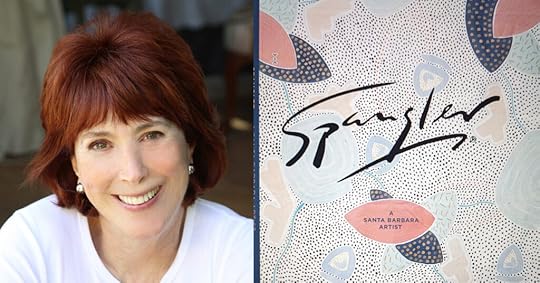
The post Spangler: A Santa Barbara Artist by Penny Paine appeared first on Elizabeth Appraisals.
August 5, 2025
1970s Folk Craftsmanship
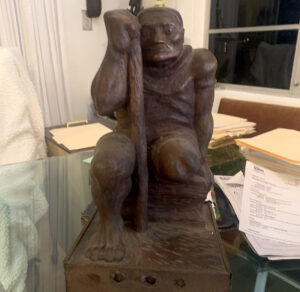 At the Boys & Girls Club, my favorite thrift store in Ventura, I found an ugly Brutalist folk art style wood carving. This one-legged man sits with a cane. For years I searched for the carver. Everyone who comes to my house says it’s the ugliest thing they’ve ever seen. I tend to pick up “orphans”—ugly art from thrift stores with no signatures.
At the Boys & Girls Club, my favorite thrift store in Ventura, I found an ugly Brutalist folk art style wood carving. This one-legged man sits with a cane. For years I searched for the carver. Everyone who comes to my house says it’s the ugliest thing they’ve ever seen. I tend to pick up “orphans”—ugly art from thrift stores with no signatures.
How did I find the artist? Years ago a high school friend leased a flat on Bleecker Street in NYC from a developer who saw the potential in The Village in the 1970s. When developer Ira Weissman died in 2023 my high school friend, who befriended him, inherited a naïve-art woodcarving in the mid-20th century folk-art style carved by Ira. When my friend sent me a photo of this work asking for an opinion of value, the work looked like my ugly thrift store find.
I learned Weissman considered the Swedish sculptor Emil G. Janel (1897-1981) his mentor. Janel, after a long career in California, became known for his Brutalist caricatures in the Scandinavian style of woodcarving. The Maxwell Galleries of the American Swedish Institute, located in the Phillips West neighborhood of Minneapolis, contains thirty-five carving by Janel, donated by Ira Weissman. Bingo. In Ventura I discovered a Swedish style naïve wood folk carving done by a 1920s immigrant to California.
l970s Tradition of Handmade CraftsJanel received the Royal Order of Vasa for his unique technique from the King of Sweden in 1965. He owned a summer house in the 1930s on the Russian River. There he gathered alder wood, which he soaked in a bucket to keep the medium wet. To Janel, wet alder wood seemed like living flesh. The artist termed the slightly grotesque folk art carvings “exaggerated realism.” Janel’s work fits nicely into the l970s tradition of handmade crafts, a direct reversal of austere Scandinavian design, angular and clean, which predates the 1970s crafts revival.
The 1970s revolution in craft and folk art turned away from American mass-produced culture. The art world discovered the true expression of a person was creativity, shown by a handmade work of art. Especially for an artist with no formal training. Remember the early 1970s Isley Brother’s hit: “It’s Your Thing; Do What You Want to Do! I Can’t Tell you Who to Sock it To…”
Museums began to realize ‘artifacts’ and ‘artisans’ were indeed ‘art’ and ‘artists,’ blurring the lines between fine art and craft. For example, the founding of the American Folk Art Museum on Lincoln Square in NYC, dedicated to folk and self-taught artists. Those like the Swedish American Janel, made art as an expression of individuality. A subtle political message lurked behind this movement, eschewing machine-made, post WWII furniture and décor, and turned towards “outsider” art. Unconventionality, as far from mainstream as possible, was imaged as statement of uniqueness.
Non-Educated CreativesThe field of authentic, a difficult term to define, American folk art was only a ‘field’ after the mid-20th century. Self-taught art became synonymous with American individualism, the strong influence from the counterculture and social movements that shaped this decade. The early 1970s began a legacy of respect for non-educated creatives of all kinds (poets, musicians, woodworkers, shaman, dancers) whose craftsmanship, artistic identity, brought ‘craft’ into the broader art world. If not for the ‘self-taught’ revolution of the 1970s thirtysomethings wouldn’t become experts after reading an AI Google search. We trust non-experts because of the “self-taught” revolution of the 1970s!
Many of Janel’s works were sold as “folk,” “outsider,” or “self-taught naïve” art. I notice his human figured sculptures sold in both California and Swedish auction houses in the 2020, as he’s been rediscovered today. Closely resembling my “lame” man, Janel’s “Bodybuilder” is equally imposing, and sold at Toomey Auctions estimated at $1k-2k. An old gentleman perched on a toilet at five inches tall sold for $1,747 in Stockholm Anktionsverk, a dapper but ugly “Gentleman with Walking Stick” sold for $5,250. A carving created in 1922 called “Skalvridning” (twisting the bowl) at eight inches high, showing two-figures holding a massive bowl, sold at Stockholm’s most famous auction venue, Bukowski’s for $8,400.
Thus my “outsider” folk art in the Swedish caricature tradition, found in Ventura at the Boys & Girls Club Thrift Store, is worth $4,000. Ugly, sure, but, to me, interesting and emblematic of the 1970s, weird, folk craftsmanship revolution.
Let me know in the comments below what YOU found in local thrift stores.
The post 1970s Folk Craftsmanship appeared first on Elizabeth Appraisals.
Elizabeth Stewart's Blog
- Elizabeth Stewart's profile
- 5 followers



